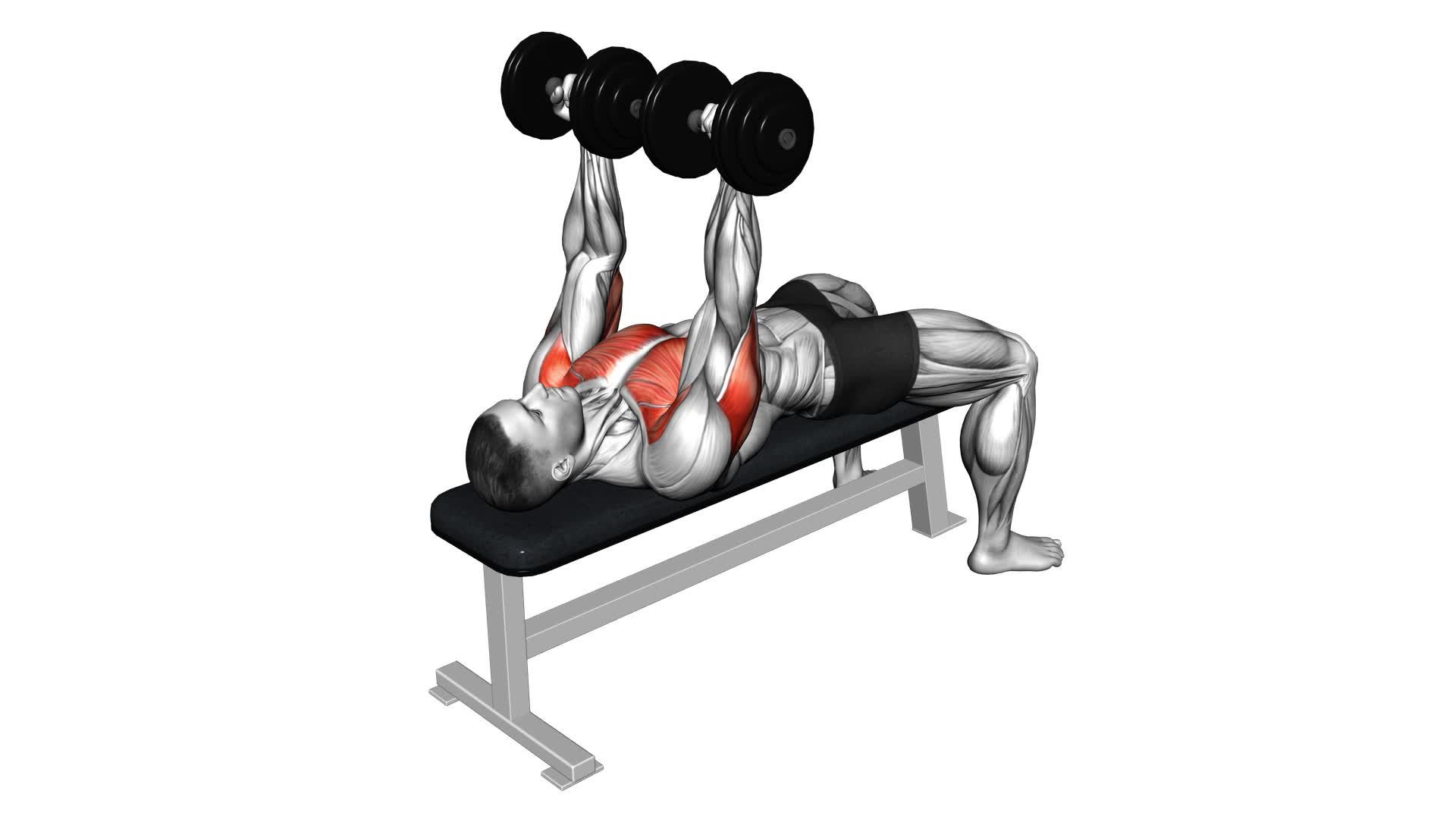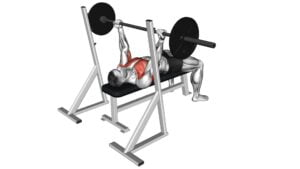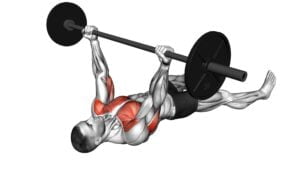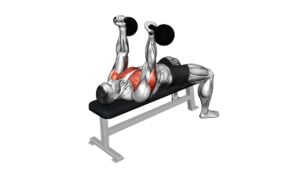Dumbbell Reverse Bench Press – Video Exercise Guide & Tips

Looking to amp up your chest workouts? Check out the Dumbbell Reverse Bench Press!
Watch This Exercise Video
In this exercise, you'll target your pectoral muscles while also engaging your triceps and shoulders. By flipping the traditional bench press motion, you'll challenge your muscles in a unique way.
This video exercise guide and tips will show you the proper form, common mistakes to avoid, and ways to progress in intensity.
Get ready to take your chest workouts to the next level!
Key Takeaways
- The dumbbell reverse bench press targets the triceps and front shoulder while engaging multiple muscle groups at once.
- It improves grip strength and puts less strain on the wrists and elbows compared to the regular bench press.
- Proper form and technique, such as maintaining a flat back and avoiding arching or lifting the hips off the bench, are crucial to avoid injury and maximize results.
- Variations and modifications, such as single-arm or inclined dumbbell reverse bench press, can be incorporated to challenge different muscle groups and increase intensity.
Proper Form for the Dumbbell Reverse Bench Press
To perform the dumbbell reverse bench press correctly, you should position yourself on the bench with your feet flat on the floor. This exercise is often misunderstood, and there are common misconceptions about it. Some people believe that it primarily targets the chest muscles, but in reality, it primarily targets the triceps and the front of the shoulder. Another misconception is that it requires a wide grip, when in fact, a shoulder-width grip is more effective. It's important to maintain proper form throughout the exercise to avoid injury and maximize results.
To begin, lie on the bench with your back flat against it and your feet firmly planted on the floor. Hold the dumbbells with an overhand grip, palms facing towards your feet. Lower the dumbbells down towards your shoulders, keeping your elbows close to your body. Pause for a moment and then push the dumbbells back up to the starting position, fully extending your arms.
If you're looking for alternative exercises to target the same muscle groups, you can try the close-grip bench press or the triceps dip. Both of these exercises engage the triceps and the front of the shoulder, providing a similar workout to the dumbbell reverse bench press. Remember to consult with a fitness professional before incorporating any new exercises into your routine to ensure proper form and technique.
Benefits of the Dumbbell Reverse Bench Press
The dumbbell reverse bench press provides numerous benefits for your triceps and front shoulder muscles. One of the main benefits of this exercise is that it targets multiple muscle groups at once, making it a time-efficient exercise for those looking to maximize their workout. By using dumbbells instead of a barbell, you can also work on improving your grip strength.
Additionally, the reverse grip used in this exercise puts less strain on your wrists and elbows compared to a regular bench press, reducing the risk of injury.
Another benefit of the dumbbell reverse bench press is that it helps to improve your overall upper body strength. By targeting your triceps and front shoulder muscles, this exercise can help you build lean muscle mass and increase your overall strength. It also helps to improve your posture and stability, as it engages your core muscles to maintain proper form throughout the exercise.
To get the most out of the dumbbell reverse bench press, it's important to use proper technique. Make sure to keep your elbows close to your body and lower the dumbbells slowly and controlled. Avoid using momentum to lift the weights, as this can decrease the effectiveness of the exercise.
Common Mistakes to Avoid During the Dumbbell Reverse Bench Press
Avoid these common mistakes when performing the dumbbell reverse bench press to ensure maximum effectiveness and prevent injury.
- Using too much weight: One of the most common mistakes is using weights that are too heavy. This can lead to improper form and put unnecessary strain on your muscles and joints. Start with lighter weights and gradually increase as you become more comfortable and confident with the exercise.
- Arching your back: It's important to maintain proper form during the dumbbell reverse bench press. Avoid arching your back excessively, as this can put strain on your lower back and increase the risk of injury. Keep your back flat against the bench throughout the exercise.
- Flaring your elbows: Another common mistake is allowing your elbows to flare out to the sides during the exercise. This can put strain on your shoulders and decrease the effectiveness of the exercise. Keep your elbows tucked in close to your body as you press the dumbbells up.
- Raising your hips: Some people have a tendency to lift their hips off the bench during the exercise. This can compromise your stability and decrease the effectiveness of the exercise. Keep your hips firmly planted on the bench throughout the movement.
Variations and Modifications for the Dumbbell Reverse Bench Press
For added intensity, you can incorporate different variations and modifications into your dumbbell reverse bench press routine. These modifications can help target specific muscle groups and challenge your strength and stability in new ways.
One modification you can try is the single-arm dumbbell reverse bench press. Instead of using both dumbbells simultaneously, hold one dumbbell in each hand and press them up one at a time. This variation increases the demand on your core muscles and can help improve balance and coordination.
Another advanced modification is the inclined dumbbell reverse bench press. To perform this variation, adjust the bench to an incline position. This increases the difficulty of the exercise and places more emphasis on your upper chest muscles. Be sure to choose an appropriate weight as the incline position may require less resistance than the flat bench press.
If you're looking to challenge your stability even further, you can try the dumbbell reverse bench press on a stability ball. This variation requires you to engage your core muscles even more to maintain balance on the unstable surface. It also targets your stabilizer muscles, helping to improve overall strength and control.
Remember to always use proper form and start with lighter weights before progressing to advanced variations. Incorporating these modifications into your dumbbell reverse bench press routine can help you continue to challenge your muscles and make progress towards your fitness goals.
Tips for Progressing and Increasing Intensity in the Dumbbell Reverse Bench Press
To increase the intensity and continue challenging your muscles in the dumbbell reverse bench press, there are several tips you can implement:
- Increase the weight gradually: As you become stronger, it's important to keep challenging your muscles by gradually increasing the weight you use for the dumbbell reverse bench press. Start with a weight that allows you to perform the exercise with proper form and then gradually increase it as you feel comfortable.
- Adjust your rep range: Changing the number of repetitions you perform can also increase the intensity of the exercise. If you've been doing a higher number of reps, try decreasing it and lifting heavier weights. Conversely, if you've been lifting heavy with low reps, try increasing the reps with lighter weights.
- Incorporate supersets or drop sets: Supersets involve performing two different exercises back-to-back without rest, while drop sets involve performing a set with a heavier weight until failure, then immediately reducing the weight and continuing the set. Both techniques can help increase the intensity and challenge your muscles.
- Slow down the tempo: By slowing down the tempo of your repetitions, you can increase the time under tension and make the exercise more challenging. Focus on controlling the movement both on the way down and on the way up, rather than rushing through the exercise.
Frequently Asked Questions
How Many Sets and Reps Should I Do for the Dumbbell Reverse Bench Press?
When it comes to the dumbbell reverse bench press, the number of sets and reps you should do depends on your fitness goals and current level of strength.
It's important to start with a weight that challenges you, but allows you to maintain proper form.
Generally, a good starting point is 3-4 sets of 8-12 reps.
This exercise targets your chest, shoulders, and triceps, and can help improve upper body strength and stability.
Can I Use a Barbell Instead of Dumbbells for the Reverse Bench Press?
Yes, you can definitely use a barbell instead of dumbbells for the reverse bench press.
The reverse bench press is a great exercise for targeting your chest, shoulders, and triceps.
While using dumbbells allows for more stability and independent arm movement, using a barbell can help you lift heavier weights and build overall strength.
Just make sure to maintain proper form and technique to avoid any potential injuries.
Should I Fully Extend My Arms at the Top of the Movement?
When performing the reverse bench press, it's important to focus on proper form and arm extension. Fully extending your arms at the top of the movement helps engage your triceps and chest muscles more effectively. This ensures that you're getting the most out of the exercise and targeting the intended muscle groups.
Remember to maintain control throughout the entire movement to avoid any unnecessary strain or injury.
Is It Normal to Feel Shoulder Pain During the Dumbbell Reverse Bench Press?
Feeling shoulder pain during the dumbbell reverse bench press isn't uncommon. There are several potential causes for this discomfort. It could be due to improper form or technique, overloading the weight, or having weak shoulder muscles.
To prevent shoulder pain, make sure to use proper form, start with lighter weights, and gradually increase the load. Additionally, incorporating shoulder-strengthening exercises into your routine can help prevent future discomfort.
Can the Dumbbell Reverse Bench Press Help Improve My Posture?
Incorporating the dumbbell reverse bench press into your workout routine can have numerous benefits, including improved posture. By targeting the muscles in your upper back and shoulders, this exercise helps strengthen the muscles responsible for maintaining proper posture.
To execute the dumbbell reverse bench press for optimal results, lie face down on a bench. Hold the dumbbells with palms facing down and lift the weights towards your back while squeezing your shoulder blades together.
Conclusion
In conclusion, the dumbbell reverse bench press is an effective exercise for targeting the muscles of the chest, shoulders, and triceps.
By maintaining proper form and avoiding common mistakes, this exercise can help improve upper body strength and stability.
Additionally, variations and modifications can be made to accommodate different fitness levels and goals.
Remember to gradually increase intensity and challenge yourself as you progress.
Incorporating the dumbbell reverse bench press into your workout routine can yield great results.

Author
Years ago, the spark of my life’s passion ignited in my mind the moment I stepped into the local gym for the first time. The inaugural bead of perspiration, the initial endeavor, the very first surge of endorphins, and a sense of pride that washed over me post-workout marked the beginning of my deep-seated interest in strength sports, fitness, and sports nutrition. This very curiosity blossomed rapidly into a profound fascination, propelling me to earn a Master’s degree in Physical Education from the Academy of Physical Education in Krakow, followed by a Sports Manager diploma from the Jagiellonian University. My journey of growth led me to gain more specialized qualifications, such as being a certified personal trainer with a focus on sports dietetics, a lifeguard, and an instructor for wellness and corrective gymnastics. Theoretical knowledge paired seamlessly with practical experience, reinforcing my belief that the transformation of individuals under my guidance was also a reflection of my personal growth. This belief holds true even today. Each day, I strive to push the boundaries and explore new realms. These realms gently elevate me to greater heights. The unique combination of passion for my field and the continuous quest for growth fuels my drive to break new ground.







